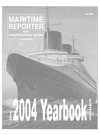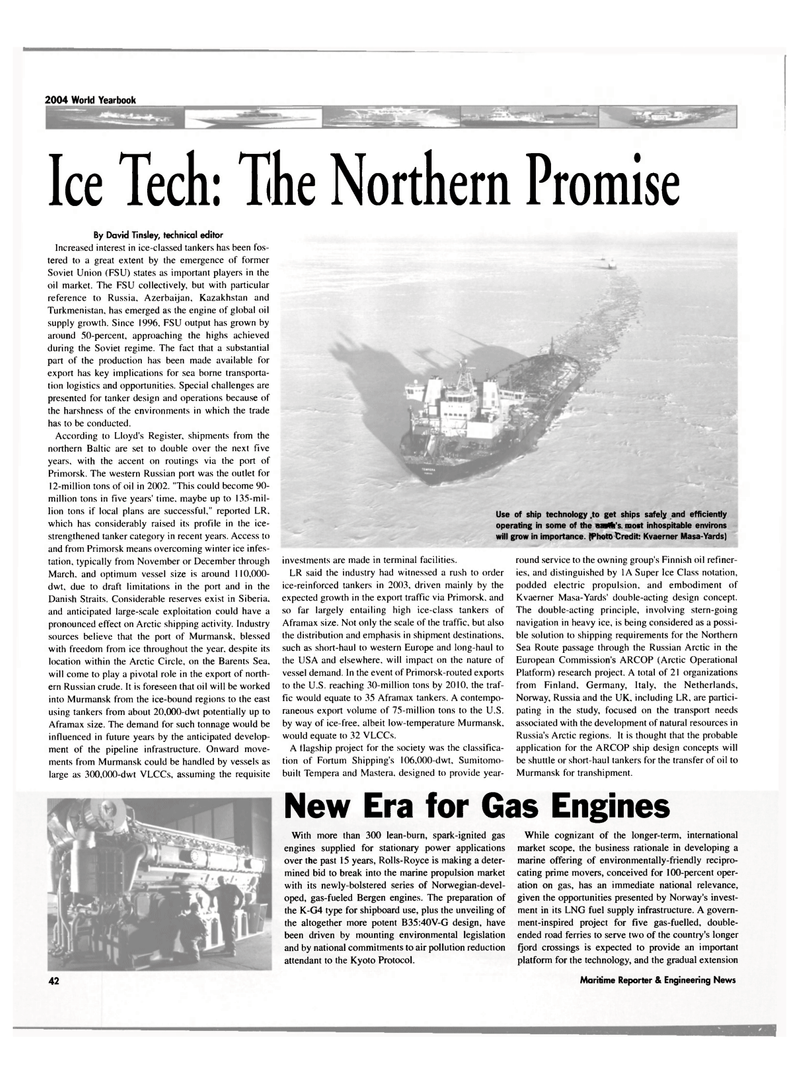
Page 42: of Maritime Reporter Magazine (June 2004)
Annual World Yearbook
Read this page in Pdf, Flash or Html5 edition of June 2004 Maritime Reporter Magazine
2004 World Yearbook
Ice Tech: The Northern Promise
By David Tinsley, technical editor
Increased interest in ice-classed tankers has been fos- tered to a great extent by the emergence of former
Soviet Union (FSU) states as important players in the oil market. The FSU collectively, but with particular reference to Russia, Azerbaijan, Kazakhstan and
Turkmenistan, has emerged as the engine of global oil supply growth. Since 1996, FSU output has grown by around 50-percent, approaching the highs achieved during the Soviet regime. The fact that a substantial part of the production has been made available for export has key implications for sea borne transporta- tion logistics and opportunities. Special challenges are presented for tanker design and operations because of the harshness of the environments in which the trade has to be conducted.
According to Lloyd's Register, shipments from the northern Baltic are set to double over the next five years, with the accent on routings via the port of
Primorsk. The western Russian port was the outlet for 12-million tons of oil in 2002. "This could become 90- million tons in five years' time, maybe up to 135-mil- lion tons if local plans are successful," reported LR, which has considerably raised its profile in the ice- strengthened tanker category in recent years. Access to and from Primorsk means overcoming winter ice infes- tation, typically from November or December through
March, and optimum vessel size is around 110,000- dwt, due to draft limitations in the port and in the
Danish Straits. Considerable reserves exist in Siberia, and anticipated large-scale exploitation could have a pronounced effect on Arctic shipping activity. Industry sources believe that the port of Murmansk, blessed with freedom from ice throughout the year, despite its location within the Arctic Circle, on the Barents Sea, will come to play a pivotal role in the export of north- ern Russian crude. It is foreseen that oil will be worked into Murmansk from the ice-bound regions to the east using tankers from about 20,000-dwt potentially up to
Aframax size. The demand for such tonnage would be influenced in future years by the anticipated develop- ment of the pipeline infrastructure. Onward move- ments from Murmansk could be handled by vessels as large as 300,000-dwt VLCCs, assuming the requisite
New Era for Gas Engines
With more than 300 lean-burn, spark-ignited gas engines supplied for stationary power applications over the past 15 years, Rolls-Royce is making a deter- mined bid to break into the marine propulsion market with its newly-bolstered series of Norwegian-devel- oped, gas-fueled Bergen engines. The preparation of the K-G4 type for shipboard use, plus the unveiling of the altogether more potent B35:40V-G design, have been driven by mounting environmental legislation and by national commitments to air pollution reduction attendant to the Kyoto Protocol.
While cognizant of the longer-term, international market scope, the business rationale in developing a marine offering of environmentally-friendly recipro- cating prime movers, conceived for 100-percent oper- ation on gas, has an immediate national relevance, given the opportunities presented by Norway's invest- ment in its LNG fuel supply infrastructure. A govern- ment-inspired project for five gas-fuelled, double- ended road ferries to serve two of the country's longer fjord crossings is expected to provide an important platform for the technology, and the gradual extension
Use of ship technology to get ships safely and efficiently operating in some of the earth's most inhospitable environs will grow in importance. (Photo Credit: Kvaerner Masa-Yards) investments are made in terminal facilities.
LR said the industry had witnessed a rush to order ice-reinforced tankers in 2003, driven mainly by the expected growth in the export traffic via Primorsk, and so far largely entailing high ice-class tankers of
Aframax size. Not only the scale of the traffic, but also the distribution and emphasis in shipment destinations, such as short-haul to western Europe and long-haul to the USA and elsewhere, will impact on the nature of vessel demand. In the event of Primorsk-routed exports to the U.S. reaching 30-million tons by 2010, the traf- fic would equate to 35 Aframax tankers. A contempo- raneous export volume of 75-million tons to the U.S. by way of ice-free, albeit low-temperature Murmansk, would equate to 32 VLCCs.
A flagship project for the society was the classifica- tion of Fortum Shipping's 106,000-dwt, Sumitomo- built Tempera and Mastera. designed to provide year- round service to the owning group's Finnish oil refiner- ies, and distinguished by 1A Super Ice Class notation, podded electric propulsion, and embodiment of
Kvaerner Masa-Yards' double-acting design concept.
The double-acting principle, involving stern-going navigation in heavy ice, is being considered as a possi- ble solution to shipping requirements for the Northern
Sea Route passage through the Russian Arctic in the
European Commission's ARCOP (Arctic Operational
Platform) research project. A total of 21 organizations from Finland, Germany, Italy, the Netherlands,
Norway, Russia and the UK. including LR, are partici- pating in the study, focused on the transport needs associated with the development of natural resources in
Russia's Arctic regions. It is thought that the probable application for the ARCOP ship design concepts will be shuttle or short-haul tankers for the transfer of oil to
Murmansk for transhipment. 42 Maritime Reporter & Engineering News

 41
41

 43
43
